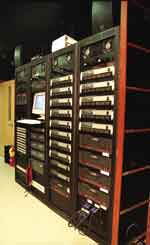
Then there are labor issues, which are looked at very differently in terms of workers doing permanent installations versus those dealing with temporary sound systems.
A “different” (translation: higher) pay rate is generally required when the troops are installing. There may be also union issues. Some areas require IBEW (International Brotherhood of Electrical Workers) membership to even pull wire.
Usually there are apprenticeship programs, journeyman to apprentice ratio requirements and a ton of administration to do to qualify for union jobs.
Many low-voltage contracting companies simply retain a licensed electrical contractor to pull wire, mount back boxes, run conduit, supply rack power and even hang loudspeaker cabinets.
Sort of like working with an IATSE (International Alliance of Theatrical Stage Employees, Moving Picture Technicians, Artists and Allied Crafts) crew, except that members of this union are familiar with audio equipment while most electricians are not. Extra supervision will be required if this is the path is chosen. Any work done in conjunction with union labor will prove to be an exercise in dealing with both the regulatory and the political.
Fielding Challenges
The install market also requires one learn the art of the project bid. “Backdoor, sweetheart” deals with certain customers or not, there will almost always be challenges from others wanting the same work, and the best way to get it is via a competitive bid.
Sounds familiar, eh? Bruce Main’s Seventh Axiom: “It’s not the job you DON’T get but the job you DO get that can kill you.”
Horror stories abound regarding contractors getting “sunk” in jobs. They bid too low, don’t verify conditions on the job site, run into the aforementioned code or union issues, plan poorly, and ultimately get in over their heads and lose their posteriors.
Thus a process must be established that includes bid analysis, site inspection, architectural drawing review, preliminary system block diagrams (in CAD format), parts/equipment price verification, and wire and termination type lists. These all come together in a bid spreadsheet from hell.
Next, someone who didn’t generate this data (preferably someone who knows what they’re doing) needs to check it.
And there is etiquette to the bid process. Strange as it may seem, you can’t always just call the consultant and ask a question, but rather, may need to generate an RFI (Request for Information) that is disseminated to all other bidders.
Approved bidder lists, job walk-through, bid openings and due diligence are all terms and processes to become familiar with.

